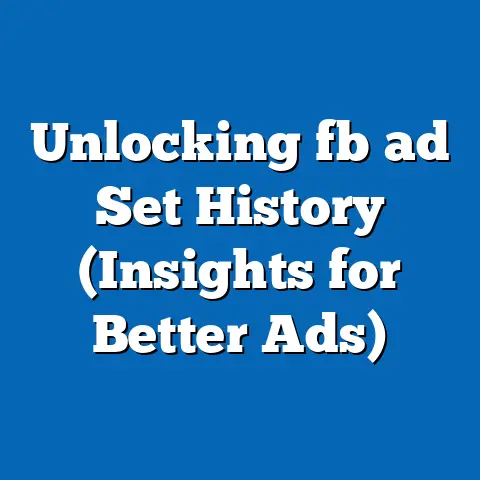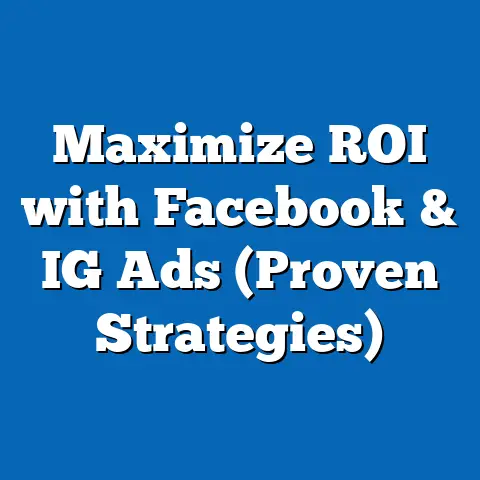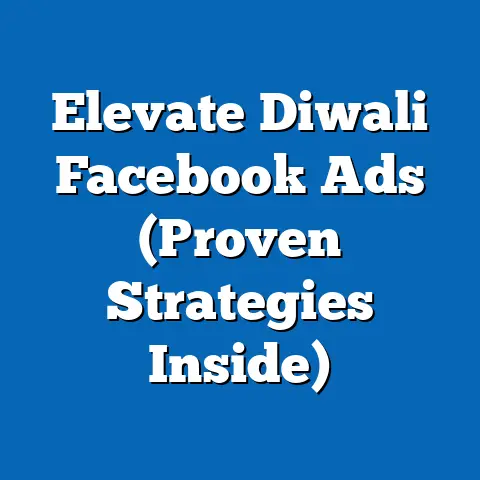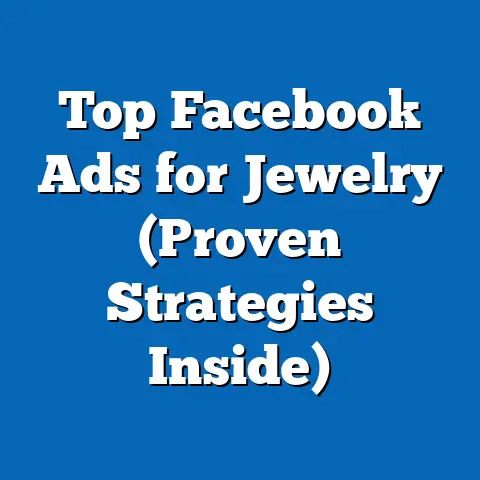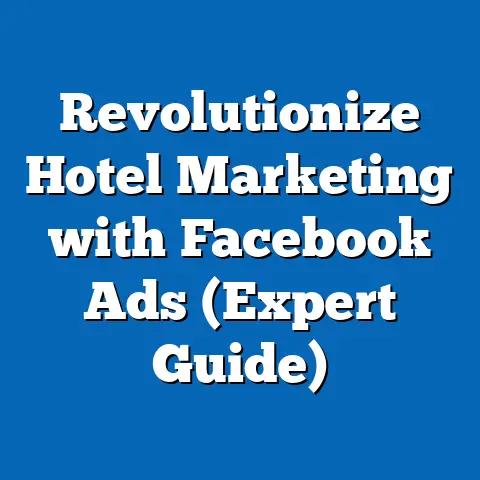Transform Facebook Ads with Adblock (Essential Strategies)
Remember the days when scrolling through your Facebook feed felt more like a leisurely journey than a barrage of ads? I do. Back then, Facebook felt more like a social network and less like a battleground for our attention. Today, it’s a completely different story. Ads are everywhere, vying for our clicks, likes, and ultimately, our wallets. But what happens when users fight back? That’s where ad blockers come into play, and they’re changing the game for Facebook advertisers. In this article, I’ll guide you through understanding the impact of ad blockers and, more importantly, how to transform your Facebook ad strategy to thrive in this new landscape.
The Evolution of Facebook Advertising
From its humble beginnings as a social networking site for college students, Facebook has morphed into a global advertising powerhouse. I remember when ads were a relatively rare sight on the platform, almost an afterthought. But as Facebook’s user base exploded, so did its advertising potential.
The early days of Facebook advertising were pretty basic. Think simple text ads and rudimentary targeting. But over time, Facebook’s algorithms became incredibly sophisticated, offering advertisers granular control over who sees their ads. We went from targeting based on broad demographics to zeroing in on specific interests, behaviors, and even life events.
This increasing sophistication also meant a proliferation of ad formats. We now have image ads, video ads, carousel ads, lead generation ads, and more. Each format is designed to capture attention and drive specific actions. However, this constant bombardment has led to a growing sense of “ad fatigue” among users, contributing to the rise of ad blockers.
Takeaway: Facebook advertising has evolved dramatically, offering incredible targeting capabilities but also leading to ad fatigue among users.
Understanding Adblock: The Basics
So, what exactly is Adblock? Simply put, it’s software designed to prevent ads from appearing on websites and social media platforms. I think of it as a digital bouncer, keeping unwanted advertisements from crashing the party.
Ad blockers work by using filter lists and algorithms to identify and block ad-related content. These filters can block specific URLs, images, scripts, and other elements commonly associated with advertising.
There are various types of ad blockers available, from browser extensions like AdBlock and Adblock Plus to dedicated apps for mobile devices. Some ad blockers are free, while others offer premium features for a fee.
The popularity of ad blockers has skyrocketed in recent years, driven by users’ desire for a cleaner, faster, and less intrusive online experience. I’ve seen many friends and colleagues install ad blockers, citing reasons like reducing page load times, conserving data usage, and simply avoiding annoying ads.
Takeaway: Adblock is software that blocks ads, becoming increasingly popular as users seek a less intrusive online experience.
The Impact of Adblock on Facebook Advertising
The rise of ad blockers has significant implications for Facebook advertisers. I’ve witnessed firsthand how ad blocking can negatively impact campaign performance.
One of the most immediate effects is a decrease in ad impressions. If an ad blocker prevents your ad from being displayed, it won’t generate an impression, which is a fundamental metric in advertising. This, in turn, can lead to lower click-through rates (CTR) and conversion rates.
Imagine you’re running a campaign to promote a new product. If a significant portion of your target audience is using ad blockers, your ads won’t reach them, resulting in fewer clicks and fewer sales. It’s like setting up shop in a ghost town – you might have a great product, but no one will see it.
Beyond impressions, ad blockers can also impact your ad spend. If your ads aren’t being seen, you’re essentially wasting money on impressions that don’t translate into meaningful engagement.
The impact of ad blocking can vary depending on your target audience and industry. Some demographics are more likely to use ad blockers than others. For example, tech-savvy users and younger audiences tend to be more inclined to block ads.
While precise statistics on the impact of ad blocking on Facebook advertising are difficult to obtain, several studies have highlighted the growing trend. For instance, reports indicate that a significant percentage of internet users worldwide use ad blockers, and this number is steadily increasing. This translates to a potentially substantial loss of revenue for businesses relying on Facebook ads.
Takeaway: Adblock significantly impacts Facebook ad performance by reducing impressions, lowering CTR and conversion rates, and potentially wasting ad spend.
Essential Strategies to Transform Facebook Ads in the Age of Adblock
So, what can you do to combat the impact of ad blockers and ensure your Facebook ads remain effective? I’ve spent years experimenting with different strategies, and here are some of the most successful approaches I’ve found:
A. Embrace Authentic Content
In an age where users are increasingly skeptical of traditional advertising, authenticity is key. I’ve seen firsthand how authentic content can cut through the noise and resonate with audiences in a way that traditional ads simply can’t.
Instead of focusing solely on selling your product or service, aim to create content that provides value, entertains, or inspires. Share stories, behind-the-scenes glimpses, and user-generated content. Show your audience the human side of your brand.
For example, consider Patagonia, a brand known for its commitment to environmental activism. Their Facebook feed is filled with stunning nature photography, stories of conservation efforts, and posts that promote sustainable practices. While they do promote their products, they do so in a way that aligns with their values and resonates with their audience.
Another great example is Dove’s “Real Beauty” campaign. By celebrating diverse body types and challenging traditional beauty standards, Dove created a powerful message that resonated with millions of women. Their ads weren’t just about selling soap; they were about promoting self-esteem and empowerment.
Tips for Creating Authentic Content:
- Know your audience: Understand their values, interests, and pain points.
- Be transparent: Share your brand’s story, including both successes and challenges.
- Showcase your values: Stand for something beyond just making a profit.
- Engage with your audience: Respond to comments, ask questions, and foster a sense of community.
- Use user-generated content: Feature testimonials, reviews, and photos from your customers.
Takeaway: Focus on creating authentic content that provides value and resonates with your audience, building trust and fostering engagement.
B. Leverage Video and Interactive Formats
Video and interactive formats are incredibly effective at capturing attention, even in the presence of ad blockers. I’ve found that video ads, in particular, tend to perform well because they’re visually engaging and can convey a lot of information in a short amount of time.
Interactive formats, such as quizzes, polls, and augmented reality (AR) experiences, can also be highly effective. These formats encourage users to actively participate with your ad, making it more memorable and engaging.
Consider the example of Buzzfeed, which is known for its engaging quizzes and interactive content. They often create sponsored quizzes that seamlessly integrate a brand’s message into the user’s experience. For example, a quiz like “Which Travel Destination Matches Your Personality?” could subtly promote a travel agency or airline.
Another example is Sephora’s AR makeup filters. These filters allow users to virtually try on different makeup products, providing a fun and interactive experience that encourages product discovery and purchase.
Tips for Optimizing Video Ads:
- Grab attention quickly: Start with a compelling visual or hook in the first few seconds.
- Keep it short and sweet: Aim for videos that are 15-30 seconds long.
- Use captions: Many users watch videos with the sound off, so captions are essential.
- Optimize for mobile: Ensure your videos are optimized for mobile viewing.
- Use a clear call to action: Tell viewers what you want them to do next (e.g., visit your website, make a purchase).
Tips for Creating Interactive Ads:
- Offer value: Ensure your interactive experience is fun, informative, or useful.
- Keep it simple: Don’t make the interaction too complicated or time-consuming.
- Make it shareable: Encourage users to share their results or experiences with their friends.
- Track your results: Monitor your engagement metrics to see what’s working and what’s not.
- Test different formats: Experiment with quizzes, polls, AR experiences, and other interactive formats.
Takeaway: Utilize video and interactive ad formats to capture user attention and encourage engagement, bypassing some of the limitations imposed by ad blockers.
C. Focus on Community Building
Building a community around your brand is a powerful way to foster loyalty and engagement. I’ve seen how brands that prioritize community building often have a much easier time reaching their audience, even in the face of ad blockers.
Instead of just pushing ads, focus on creating a space where your customers can connect with each other and with your brand. This could be a Facebook group, a forum, or even a series of live events.
Consider the example of Harley-Davidson, which has cultivated a strong community of motorcycle enthusiasts. Their Facebook group is a place where riders can share stories, ask questions, and connect with other fans of the brand.
Another great example is Lululemon, which hosts regular yoga classes and events in its stores. These events provide a way for customers to connect with the brand and with each other, fostering a sense of community.
Tips for Building a Community:
- Create a dedicated space: Set up a Facebook group, forum, or other online community.
- Encourage interaction: Ask questions, start discussions, and encourage members to share their thoughts and experiences.
- Provide value: Offer exclusive content, discounts, or other perks to community members.
- Be responsive: Respond to comments and questions promptly.
- Foster a sense of belonging: Make members feel like they’re part of something special.
- Host events: Organize online or offline events to bring your community together.
Takeaway: Prioritize building a community around your brand to foster loyalty and engagement, making your audience more receptive to your message.
D. Utilize Retargeting and Custom Audiences
Retargeting and custom audiences are incredibly powerful tools for reaching users who have already interacted with your brand. I’ve found that these strategies are particularly effective in the age of ad blockers because they allow you to target users who are already familiar with your brand and more likely to be receptive to your message.
Retargeting involves showing ads to users who have visited your website, viewed your products, or taken other actions that indicate interest in your brand. Custom audiences allow you to upload a list of email addresses or phone numbers and target those users with your ads.
For example, imagine someone visits your website and views a specific product. With retargeting, you can show them ads for that product (or similar products) as they browse Facebook. This can be a highly effective way to remind them of your brand and encourage them to make a purchase.
Another example is using a custom audience to target your email subscribers with ads. This allows you to reach them on Facebook, even if they’re not actively engaging with your emails.
Tips for Using Retargeting:
- Install the Facebook Pixel: This is essential for tracking website visitors and creating retargeting audiences.
- Segment your audiences: Create different retargeting audiences based on the actions users have taken on your website.
- Personalize your ads: Tailor your ads to the specific products or services that users have viewed.
- Use a frequency cap: Limit the number of times users see your ads to avoid annoying them.
- Test different ad formats: Experiment with image ads, video ads, and carousel ads.
Tips for Using Custom Audiences:
- Upload your email list: This is a great way to reach your existing customers on Facebook.
- Create lookalike audiences: Facebook can create audiences that are similar to your existing customers.
- Segment your audiences: Create different custom audiences based on demographics, interests, or purchase history.
- Personalize your ads: Tailor your ads to the specific segments you’re targeting.
- Test different ad formats: Experiment with different ad formats to see what works best.
Takeaway: Leverage retargeting and custom audiences to reach users who are already familiar with your brand, increasing the likelihood of engagement and conversions.
The Future of Facebook Advertising in a World with Adblock
As ad blockers become more prevalent, the future of Facebook advertising is likely to evolve in several ways. I believe we’ll see a greater emphasis on native advertising, which seamlessly integrates into the user’s experience and is less likely to be blocked by ad blockers.
We may also see the emergence of new ad formats that are more engaging and less intrusive. For example, Facebook could introduce more interactive ad formats that encourage users to actively participate with the ad, rather than simply passively viewing it.
Another potential trend is a greater focus on privacy-focused advertising. As users become more concerned about their data privacy, Facebook may need to develop new ways to target ads that don’t rely on collecting excessive amounts of personal information.
Ultimately, the future of Facebook advertising will depend on the ability of advertisers to adapt to the changing landscape and create ads that are both effective and respectful of the user’s experience.
Takeaway: The future of Facebook advertising will likely involve a greater emphasis on native advertising, engaging ad formats, and privacy-focused targeting strategies.
Conclusion
The rise of ad blockers has undoubtedly changed the game for Facebook advertisers. However, it’s not a cause for despair. Instead, it’s an opportunity to transform your advertising strategy and create ads that are more authentic, engaging, and valuable to your audience.
By embracing authentic content, leveraging video and interactive formats, focusing on community building, and utilizing retargeting and custom audiences, you can overcome the challenges posed by ad blockers and thrive in the new landscape of Facebook advertising.
Remember, transformation is not just essential; it’s an opportunity for growth. By thinking creatively and strategically about your Facebook ad campaigns, you can reach your target audience, build brand loyalty, and achieve your business goals. So, embrace the challenge and start transforming your Facebook ads today!


